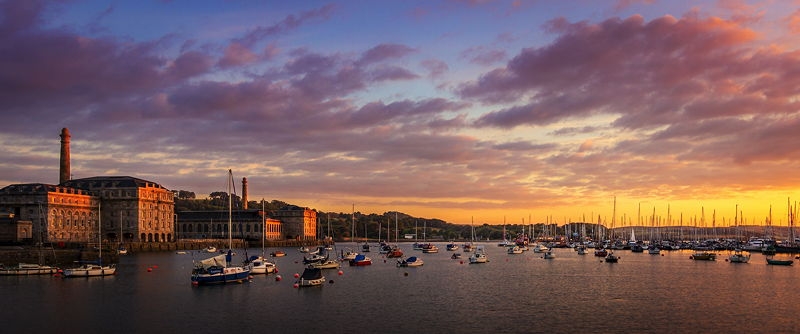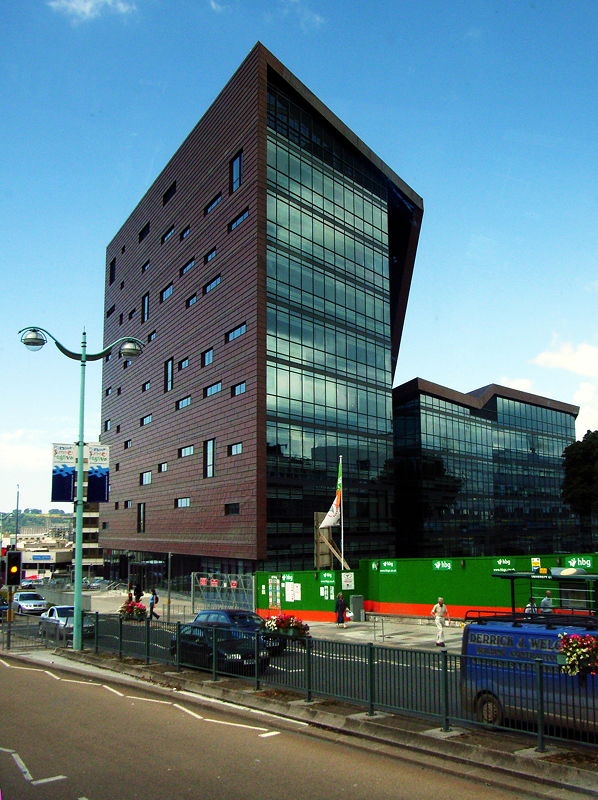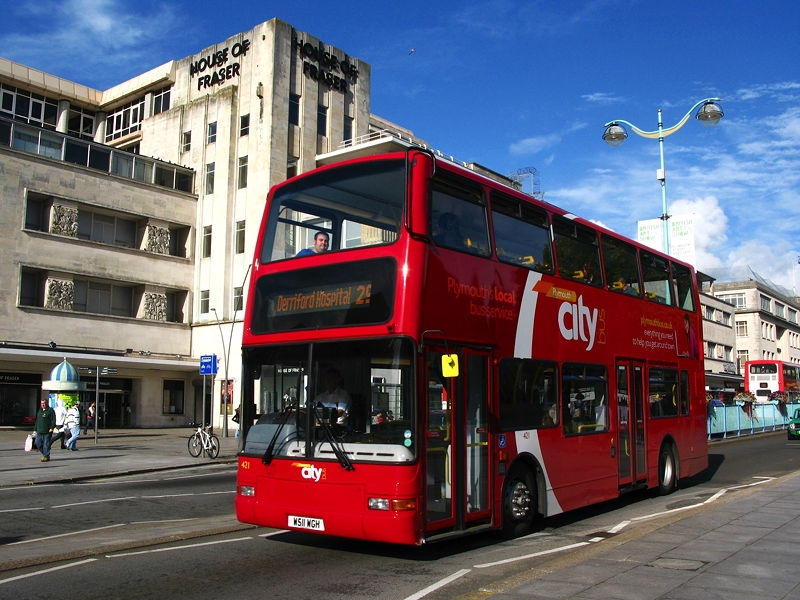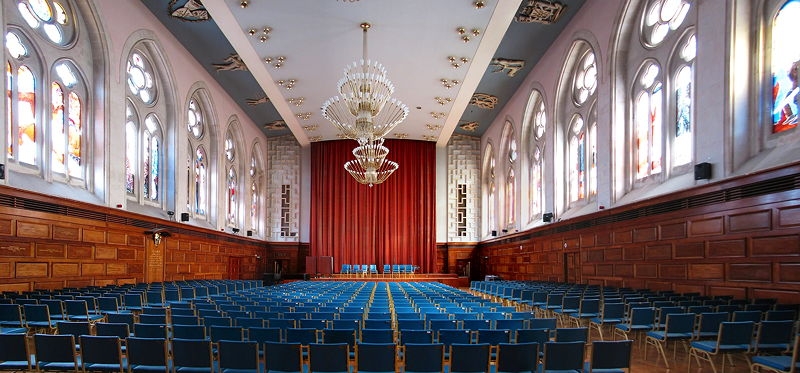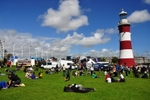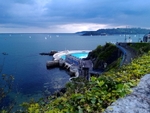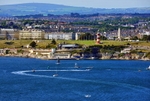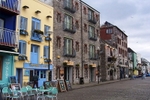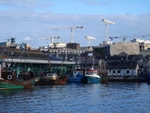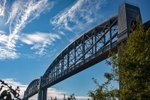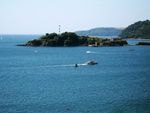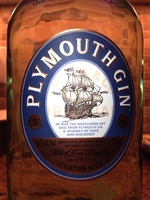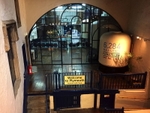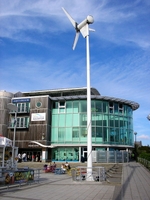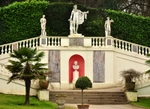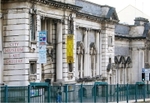1. Plymouth Hoe
As the Spanish Armada approached Britain, legend has it that Sir Francis Drake played bowls on Plymouth Hoe.
Plymouth Hoe (or just ‘The Hoe’) is a raised public space on the shorefront, offering great views of Plymouth Sound and Drake’s Island.
That game of bowls ...
Sir Francis Drake was in Plymouth in 1588 with the English navy that he commanded. The legend is that he was so relaxed about his imminent engagement with the Spanish Armada that he played a game of bowls whilst waiting for the tide to change. Today, the Hoe has a statue of Sir Francis Drake alongside a number of war memorials.
Smeaton's Tower
Other attractions include Smeaton’s Tower. This is a 72-foot lighthouse that was originally built off-shore in 1759, and which was moved to The Hoe in 1882 after it was decommissioned. It is important because it was the first lighthouse to be built using techniques developed by John Smeaton to dovetail blocks of granite and to set mortar under water (known as hydraulic lime).
Tinside Lido
Smeaton’s Tower also looks down onto the Tinside Lido. With its art deco splendour, this fabulous 1930’s lido is the perfect place to chill out on a hot day. Tinside Lido has been restored and is a wonderful example of 1930’s glamour. The outdoor salt water swimming pool looks out onto Plymouth Sound and is just the spot to cool off on a hot summer day.
Plymouth Hoe is a great place to wander about to get your bearings and get a feel for the city (by, for instance, watching ferries, warships and submarines in the harbour). It also hosts a number of military pageants and displays by the Royal Navy and Royal Marines in particular.
where? Plymouth Hoe, Plymouth
when? The Lido is open late May to early September. Weekdays 12:00-18:00; Weekends 10:00-18:00. Smeaton's Tower is open Tuesdays to Sundays (except Good Friday, Christmas Day, Boxing Day and New Year's Day), 10am to 5pm.
£$€¥ Tinside Lido: £4 for adults, £3 for children and seniors. Smeaton's Tower: £2.80 for adults, £1.50 for children.
2. The Barbican
Plymouth was heavily bombed during the Second World War. The waterfront Barbican area is home to most of the buildings that survived.
The Barbican is a delight to explore. In addition to the great sea views, you’ll find cobbled streets and narrow alleys here that are packed with history, cafes, galleries and characterful pubs.
The Mayflower Steps
On 6 September 1620 the Pilgrim Fathers led by William Bradford set sail for America from the Plymouth’s Barbican area. Their ship was the 100 foot-long Mayflower. After a gruelling 66-day voyage, the 102 passengers and 30 crew anchored at Provincetown Harbour, close to Cape Cod on America’s eastern seaboard. They established a town called Plymouth, Massachusetts nearby.
The Barbican’s Mayflower Steps mark the departure point of these early refugees. There is a steel viewing platform reached by walking through a small stone portico (found between two flagpoles which fly the Union Jack and the American flag).
The Mayflower Museum
The nearby Mayflower Museum has three floors of displays dedicated to this moment in history.
It explains why the Pilgrim Fathers left: they wanted religious freedom to (as they saw it) ‘purify’ the Catholic church, something they felt unable to do in England or on mainland Europe. As a result, they were also known as Puritans.
It also explains the conditions they suffered on their voyage to America (during which two Pilgrims perished) and the even greater suffering that ensued as they tried to build a colony (over half of the Pilgrims died in the first winter, on account of the harsh climate and an absence of fresh food – leading to numerous cases of scurvy).
The Mayflower Museum’s highlight is a 1:11 scale model of the Mayflower, complete with 360 fathom of rigging and 64 square feet of sails!
The Museum is found at 3-5 The Barbican, Plymouth, Devon, PL1 2LR and is open Monday to Saturday 9am to 5pm, Sunday 10am to 4pm. The cost is £3.50 for adults and £2 for children.
The Merchant’s House (currently closed)
One of the most interesting buildings in Plymouth is tucked away in the heart of the Barbican. The Merchant’s House was built in the 16th and 17th century and is a trove of artefacts from this period. During its time three Plymouth mayors lived here, the first of whom was William Parker. Once you climb the narrow winding staircase you’ll find all manner of Plymouth history.
The Merchant’s House is is currently closed due to essential conservation work. Make sure to see the website for more information.
3. Plymouth boat trips
Getting out on the water is a fabulous way to see Plymouth and the coastline.
One of the best trips is to take the boat past Plymouth Hoe and Drakes Island towards the River Tamar where the iconic Royal Albert Bridge is located.
Drake's Island
We introduce Plymouth Hoe above. From it is seen Drake’s Island, a 6.5-acre island approximately 400 metres offshore. Initially called St Michael’s, the island was renamed after Plymouth’s most famous son. It was from here that Sir Francis Drake set sail in 1577 to circumnavigate the world, returning three years later. He was made governor of the island in 1583.
The Island has since been used primarily for defence fortifications and as a prison (Roundhead General John Lambert, imprisoned during the English civil war, was moved here from Guernsey in 1662). More recently, the Island has been purchased by businessman Dan McCauley, who has plans to turn it into a hotel complex.
The Royal Albert Bridge
Designed by Isambard Kingdom Brunel, and completed in 1854, the Royal Albert Bridge has a length of almost 2,200 feet and is built primarily of iron. Its distinguishing features are its two 455 foot lencticular iron trusses. This famous bridge, which now carries the Cornish mainline, has featured on the British £2 coin.
You’ll see the warships and submarines in the Naval Dockyard area too and some boat trios head towards Cornwall and the beautiful coastline. Plymouth Boat Trips also run fishing tours which are popular with anglers eager to experience the waters off the city.
where? Plymouth Boat Trips is found at 2-5 Commercial Wharf, Madeira Road, Plymouth, Devon, PL1 2N
when? Daily
4. Plymouth Gin
Given its naval connection, it is no surprise that Plymouth is home to a gin distillery and some historical public houses.
Plymouth Gin Distillery
Gin has been produced at Blackfriars Distillery since 1793 and is made at Navy Strength or 57% proof.
Gin took off in Plymouth when the Navy developed a taste for the drink. In historic times gin was stored with gunpowder. Both were valuable commodities, and the strength of Navy gin helped ensure that if ever there were a spillage the gunpowder would still ignite.
Today visitors can take a guided tour of the distillery to learn more about the history of gin production in this area. Tours must be pre booked and are only for those of legal drinking age.
The Distillery is found at 60 Southside Street, the Barbican, Plymouth PL1 2LQ. It is open Monday to Saturday, 10am to 5pm, and on Sundays from 11am to 5pm. A gin tour is £12.50 (40 minutes), a connoisseur’s tour is £35 (90 minutes) and a Master Distiller's Tour—during which you get to distill your own gin—is £55 (2 hours 30 mins).
Pubs
Stop in for a pint at the Minerva Inn on Looe Street, where press gangs used to visit looking for men to join the navy. This is Plymouth's oldest surviving public house, dating from 1540. Look out for the beams and woodwork: some of the material was taken from wrecked Spanish boats following the demise of the Armada. These days, the Minerva hosts three live music events each week.
Other good pubs include the Dolphin Inn. If it looks familiar, this is because it was the setting for many of the artist Beryl Cook’s paintings of her large ladies.
5. More things to do in Plymouth
National Marine Aquarium
For a perfect place to go on a rainy day the National Marine Aquarium ticks all the boxes. Full of native species as well as several sharks and other tropical fish this is a great place to see marine life. There are interactive activities and it is a popular place for families. Don’t forget to look out for Snorkel, the loggerhead turtle.
The Aquarium is found on Rope Walk, Coxside, Plymouth, PL4 0LF and is open daily from 10am to 5pm. Tickets cost £16.95 for adults and £12.95 for children.
The Elizabethan House
Located on the Barbican the Elizabethan House is a fascinating insight into Drake’s Plymouth. Enter through the narrow doorway and you’ll discover an insight into the home of an Elizabethan sea captain. There are spiral staircases and panelled walls and this museum is a lovely place to see another side to the city.
Plymouth City Museum and Art Gallery
Just a short walk from Drake circus is the vibrant Plymouth City Museum and Art Gallery. This houses a large collection over 2 floors and includes a variety of exhibits from local maritime history to Ancient Egypt. There are also themed exhibitions throughout the year.
Mount Edgcumbe House
Located just outside Plymouth, Mount Edgcumbe House and Country Park has 10 acres of grounds to explore. It was the former home of the Earls of Mount Edgcumbe and has Grade 1 listed gardens. The historic house has some beautiful exhibits and the gardens themselves are famed for their mystical woodland areas and floral displays. Getting here is easy via the Cremyll Ferry which played a part in the Dunkirk evacuation during World War Two.
Mount Edgcume is found at Torpoint, Cornwall, PL10 1HZ. The House is open from April to October, and the country park open daily until dusk.
Plym Valley Trail
For a good walking and cycling route the Plym Valley Trail is one of the best in and around Plymouth. The route heads from Plymouth through the Plym Bridge Woods towards Dartmoor and also takes in the old Cann and Bickleigh quarries. This is a picturesque trail and the ideal way to get some exercise on a city break. The trail is found at the Cann Quarry and Bickleigh Valley Quarries, Plymouth.
Beaches in and around Plymouth
Plymouth’s coastline has some great beaches which are popular with visitors. Bovisand is near the city centre and a sheltered bay with a sandy shoreline. Further along the coast Wembury is popular with surfers and has some great walks in and around the coast and village. At Bigbury you’ll find the fabulous art deco hotel on Burgh Island, only accessible by sea tractor at high tide. The beach here is another popular place for families and also for windsurfing.
Dartmoor
Just outside Plymouth the wild moorland on Dartmoor is very popular with visitors. This is where the movie War Horse was filmed and where there are countless charming villages with tea rooms and good pubs. There is good walking here too with many classic trails. At Yelverton you’ll find Dartmoor ponies and stunning scenery whilst at Princetown there is the brooding prison with its museum. A visit to Dartmoor is a popular day trio from Plymouth and is less than an hour from the city centre by car.
Royal William Yard
The old Naval Buildings in Royal William Yard were built between 1825 and 1831 and are a prominent feature on the waterfront. Today they have seen a new lease of life, becoming a vibrant centre of arts and culture. The Yard can be reached by land and sea and has several popular restaurants. Catch the RWY Water Ferry from the Barbican or head there on foot.
It is also connected to the South West Coastal Footpath which runs from Devils Point to the Yard via a series of cantilevered steps. The views out to sea from the Royal William Yard are spectacular and a big reason to include this part of Plymouth in your visit.
